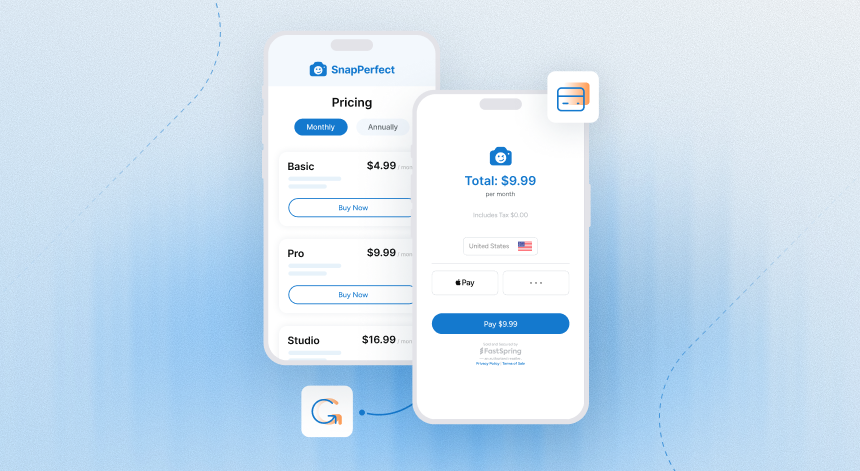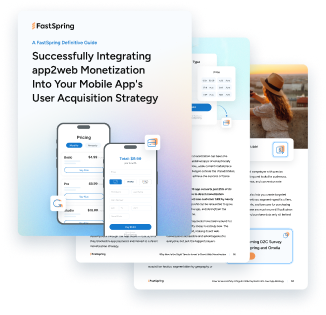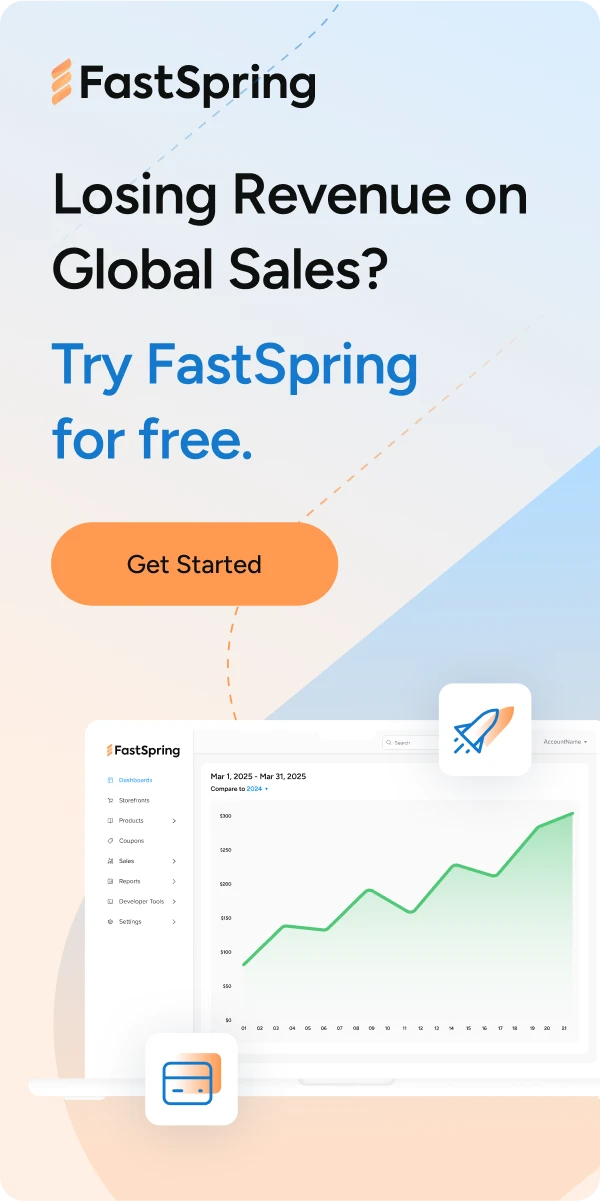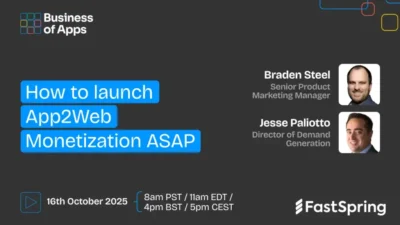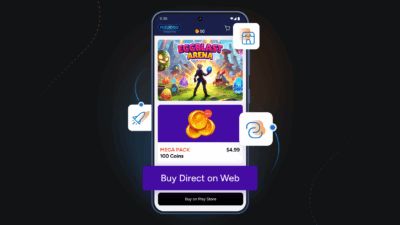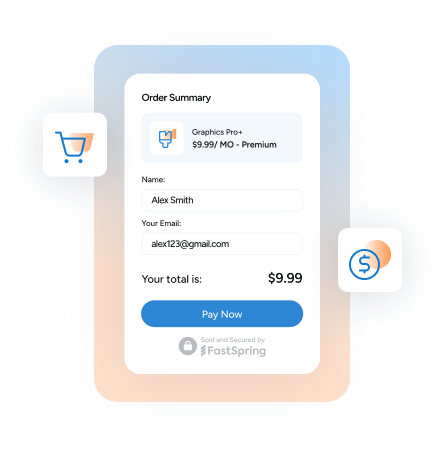TL;DR: More mobile apps are monetizing by selling subscriptions on their websites to drive user acquisition, keep more revenue, and own their user relationship, especially now that steering iOS users to your site is allowed in the US. Giants like Netflix, Spotify, Disney+, and others already monetize directly. While the approach changes the user journey, it can boost revenue margins by more than 30%. As subscriptions drive record app revenues, offering web checkout from a Merchant of Record like FastSpring has become an essential strategy to drive new user sign ups and increase revenue margin.
In recent years, mobile app developers have pushed back against marketplace fees that take up 15% to 30% of their revenue. Netflix, Spotify, and Fortnite all removed in-app subscriptions or payments to encourage users to buy on their websites instead. At its peak, Netflix alone was paying Apple an estimated $700,000 per day in fees just for offering subscriptions through the App Store.
Smaller app developers are following suit and are reaping the benefits as a result. While many aren’t removing in-app payments entirely, they are employing strategies to steer users to their websites for better user acquisition and mobile app monetization rather than relying on a middleman to do it for them.
What Are Web Subscriptions?
Web subscriptions–sometimes called web monetization–are the act of offering subscriptions for your mobile app directly from your website, instead of or in addition to in-app via app marketplaces.
When users buy subscriptions through your website, you control the checkout, collect payment details, and avoid marketplace fees—boosting your margins. You also own the customer relationship, manage subscriptions directly, and gain access to conversion data for targeted acquisition campaigns that app marketplaces don’t actively support..
Why Should Mobile App Companies Offer Web Subscriptions?
By category, subscriptions are playing a bigger role than ever. Notably on Apple’s App Store, non-game app spending is on track to overtake games. Sensor Tower forecasts that non-game app revenue will outpace in-game revenue at $107B vs $78B in 2025.
As such, the revenue and desire from users to use subscriptions is already there. The most proactive companies are using web subscriptions to not only increase revenue share, but to improve customer acquisition.
Open Up User Acquisition Analytics by Linking Ads to Your Website
Direct user relationships also open up the opportunity to run user acquisition (UA) campaigns that give more power back to you, the developer.
Many mobile app companies currently run UA campaigns that link only to App Store pages. They get more users into their apps this way, but the trade off is giving the marketplace most of their user data. Attribution is therefore limited, and it’s much harder to know which ads are performing, which channels are driving sign ups, and how to optimize your ad spend.
By instead driving ad traffic to your own website, you regain visibility into this crucial part of your users’ journey. You can collect first-party data such as traffic source, session behavior, conversion rate, MRR, and much more, all directly attributable to your campaigns. You also avoid the signal loss that happens when players only interact within the marketplace ecosystem.
With stronger attribution, you can then refine your targeting, optimize creatives, and allocate budget to the channels that drive the most revenue.
Boost Revenue With Web Subscriptions
Each time a user transacts within the App Store or Play Store there’s a fee–often 30%. That’s a significant share of your revenue lost before you ever see a deposit into your account, limiting your ability to reinvest in your business and ultimately, grow.
Web subscriptions reduce that cost nearly immediately. If you offer users the ability to purchase through your website with a partner like FastSpring, you typically pay about 6% in fees, including processing and infrastructure. That difference–24% or more per transaction–adds up fast.
Let’s take a look at an example of a business offering web subscriptions in addition to in-app purchases:
| Channel | Gross Revenue | Fee | Net Revenue |
| App Store | $750,000 | 30% | $525,0500 |
| Web | $250,000 | 6% | $235,000 |
| Total | $1,000,000 | – | $760,000 |
By shifting just 25% of transactions to the web, this business would see $60,000 in monthly profit, or $720,000 annually. If you grow or migrate more volume to web subscriptions, that number scales quickly.
And these benefits don’t just apply to bottom line revenue. Alongside better margins per transaction, leveraging web subscriptions, mobile app companies can create a direct relationship with their users which leads to attribution data and ultimately the ability to reinvest confidently in the channels that deliver the highest return.
Establish a Direct Relationship With Users
One of the most vital parts of web subscriptions is that when you sell directly to your users, you aren’t just driving more revenue. You’re also building a direct relationship with your users.
The reality today is, nobody follows their meditation app on social media, few users are joining a discord for their video editing app, and users aren’t signing up for a newsletter from their favorite messaging app. Plus, with different platform access points like mobile, web, tablet, and elsewhere your user base is fragmented at best.
Without a unifying backbone behind those platforms, you don’t have a real relationship with your users. Nor do you have a way to market to them.
By creating a web store offering web subscriptions and account management, you unlock a direct line of communication instead of “renting” your audience from app marketplaces. You control your channels, your data, and ultimately, your user relationships. A direct user relationship means you can market to them and engage with them as they use your app across different platforms, today and into the future.
With direct user access, you can leverage marketing tactics such as retargeting pixels, targeted social ad campaigns, community-driven advocacy, and more. All of these tools let you connect with your users regardless of the platform they engage on, drive boosted conversion rates, and build brand loyalty over time. And according to a Harvard study, increasing retention (via loyalty) by just 5% delivers between 25% to 95% higher profits over time.
Web Subscriptions are More Common (and Stickier Than Ever)
The most successful mobile app companies are already offering web subscriptions, and it’s paying off. Even a few years ago, it would have been unorthodox to consider offering subscriptions outside of an app, but now, web store purchase flows have been normalized and users are more convinced of the value of making subscription purchases on your site instead of through the app stores.
Plus, in the US, mobile app companies are allowed to steer users to their websites directly from in-app on iOS. What does that mean? Users are learning about a channel that was previously difficult to find and mobile app developers who were ready are already reaping the benefits.
As more users get used to subscribing via your website, linking ads directly to your web store becomes a natural part of the funnel, reducing friction and improving ROI via customer acquisition.
Web Subscriptions Are Already Allowed — and Growing Fast
For years, many app developers assumed that offering web subscriptions was against marketplace terms of service, and users were unfamiliar with purchase flows outside of the app store. But, that’s not true at all.
Under current terms of service, offering web subscriptions to your users is allowed and on iOS, you’re even allowed to steer users from in-app directly to your website to make a purchase if they’re buying from the US.
And, regulatory shifts in the EU (Digital Markets Act) and Japan (Smartphone Act) mandate broader support for third-party payments and alternative app stores. Brazil is following closely, with active investigations and legislation proposals aimed at reducing marketplace control and giving power back to developers and users.
The Time for Web Subscriptions Is Now — Partner With FastSpring
Offering web subscriptions on your website is a no brainer. Revenue goes up, you own more user data, and open up the ability to market to your users. Plus, when you partner with FastSpring, you get access to our varied subscription capabilities including:
- Subscription management APIs
- Coupons and discount services
- The most popular payment methods used around the world
- Instant currency localization
- Managed tax compliance across the globe
- …and more.
If you have questions about how to start offering web subscriptions, or want to learn more about how FastSpring can help you drive business growth, set up a call with one of our industry experts today to get started.




